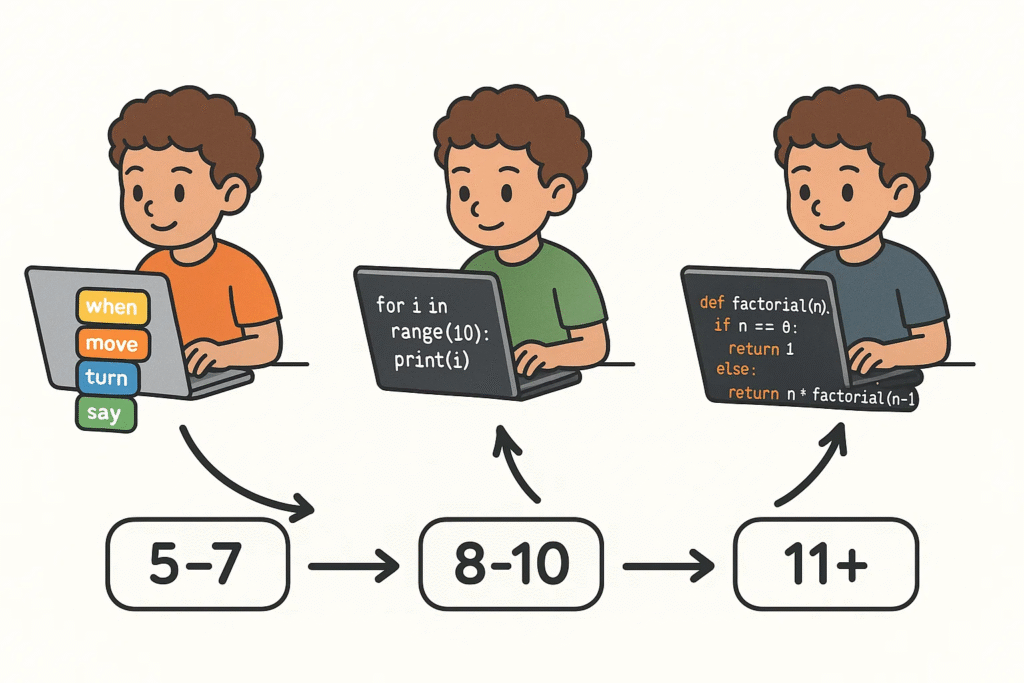
Reading Time: 5 mins

Are you wondering whether your child should start with colorful drag-and-drop blocks or jump straight into traditional code? You’re not alone. Many parents face this crucial decision when introducing their kids to programming. The wrong choice could either frustrate your child or limit their potential growth in technology.
Here’s the good news: understanding the differences between block-based and text-based coding will help you make the perfect choice for your child’s unique learning style and age. In this comprehensive guide, we’ll explore both approaches, their benefits, and how to determine which path will set your young coder up for success.

Block-based coding, also known as visual programming, uses colorful, puzzle-like blocks that children drag and drop to create programs. Think of it as digital LEGO blocks where each piece represents a specific command or function. Instead of typing complex syntax, kids simply snap blocks together to build their code.
Popular block-based platforms include:
The beauty of block-based coding lies in its intuitive nature. Children can focus on learning programming logic without getting overwhelmed by complicated syntax rules. It’s like learning to drive in an automatic car before tackling manual transmission.
Text-based coding involves writing actual code using programming languages like Python, JavaScript, or C++. Children type specific commands, follow strict syntax rules, and debug errors by reading and understanding written code.
Common beginner-friendly text languages include:
Text-based coding requires more attention to detail and abstract thinking. It’s like learning to write poetry – you need to understand grammar, vocabulary, and structure to create something meaningful.

Block-based coding offers immediate gratification. Kids as young as 5 can start creating animations and simple games within their first session. The visual nature makes abstract programming concepts tangible and understandable.
Text-based coding has a steeper learning curve. Children typically need stronger reading and typing skills, making it more suitable for ages 8 and above. However, it provides deeper understanding of how computers actually process instructions.
With block-based platforms, children can quickly create impressive projects like interactive stories, animations, and games. Scratch coding offers numerous benefits including immediate visual feedback and built-in sharing capabilities.
Text-based coding opens unlimited possibilities. Once children master the fundamentals, they can build websites, mobile apps, and even artificial intelligence programs. The only limit is their imagination and skill level.
Block-based coding serves as an excellent stepping stone. Many successful programmers started with visual programming before transitioning to text-based languages. It builds confidence and establishes fundamental programming concepts.
Text-based coding is essential for serious programming careers. While block-based coding teaches logic, text-based coding teaches the actual language of computers.
Start with simple drag-and-drop interfaces. Teaching kids block coding at this age focuses on:
Children can handle more complex block-based projects while beginning to see the actual code behind the blocks. Many platforms show both block and text views simultaneously.
Ready for coding languages suitable for game development and real-world applications. Python often serves as the first text-based language due to its readability.

Research shows that block-based coding offers significant advantages for young learners, including improved spatial reasoning and logical thinking skills.
Consider these factors when choosing between block-based and text-based coding:
Choose Block-based If:
Choose Text-based If:
Many successful coding programs combine both approaches. Start with blocks to build confidence and understanding, then gradually transition to text-based coding. This progression mirrors how professional developers actually work – they often prototype with visual tools before writing production code.
Online coding education benefits include the flexibility to seamlessly transition between different coding approaches as children develop their skills.
Both block-based and text-based coding have crucial roles in your child’s programming journey. Block-based coding provides the perfect introduction, building confidence and foundational concepts through engaging, visual experiences. Text-based coding offers the pathway to professional programming skills and unlimited creative possibilities.
The key is starting where your child feels comfortable and confident, then gradually progressing as their skills and interests develop. Remember, the goal isn’t to rush into complex programming but to foster a lifelong love of technology and problem-solving.
Ready to start your child’s coding adventure? Explore our coding programs designed specifically for young learners, combining the best of both block-based and text-based approaches to create confident, creative programmers.
